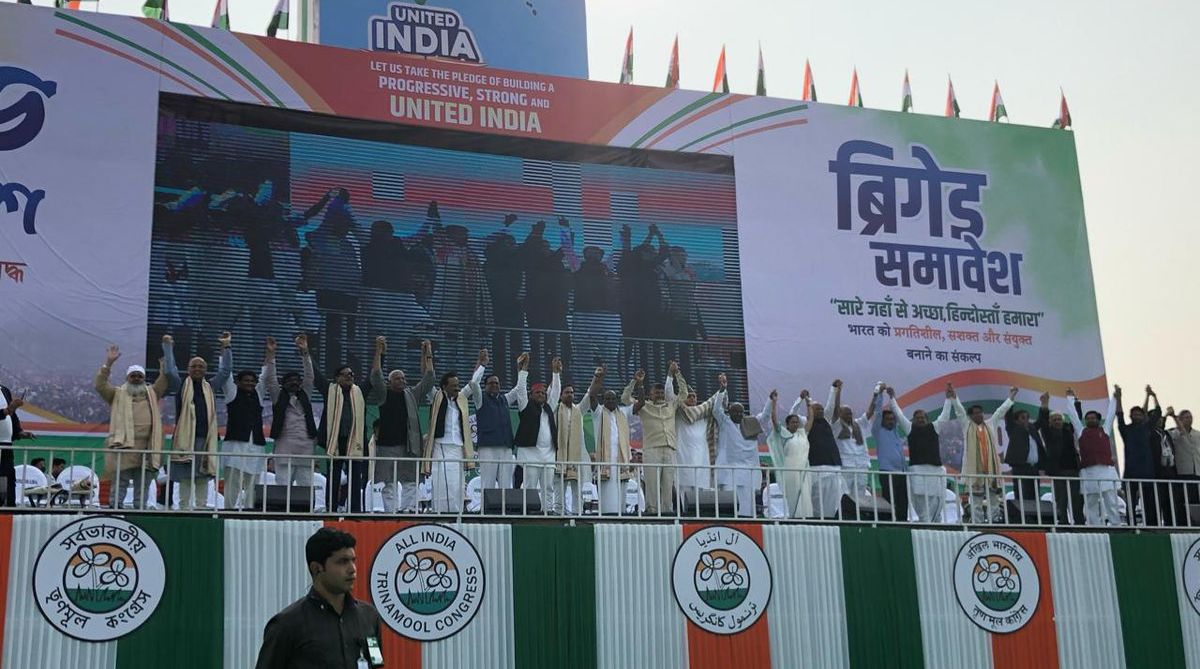Rahul will announce candidacy from Amethi after Wayanad polls: Himanta
Sarma suggested that this move aligns with Prime Minister Modi's previous assessment of the Congress party's strategy.
The SP and the BSP, which are key players in Uttar Pradesh with its 80 Lok Sabha seats, were not present at the meetings, they have already formed an alliance for the Lok Sabha polls.

The 'united opposition' at the mega rally at Kolkata’s Brigade Parade Ground. (Photo: Twitter/@AITCofficial)
Are the opposition parties getting united to fight against the ruling Bharatiya Janata Party, now that the Lok Sabha polls are just round the corner? Congress President Rahul Gandhi, Nationalist Congress Party chief Sharad Pawar and West Bengal chief minister Mamata Banerjee have been batting for opposition unity for some time and others like Andhra Pradesh chief minister Chandrababu Naidu and Delhi chief minister Arvind Kejriwal have now chipped in. Their common objective is to oust Prime Minister Narendra Modi in the ensuing Lok Sabha polls but their idea of a ‘Mahagathbandhan’ (Grand Alliance) is yet to take concrete shape. Meanwhile, the opposition has tried to show its unity since May last when they held hands at the swearing-in ceremony of Karnataka chief minister H D Kumaraswamy.
The Delhi venture is the latest in these efforts. After the impressive Kolkata unity rally organised by Mamata Banerjee on 19 January, Kejriwal organised a rally on Wednesday in which leaders from 15 parties participated. They included the Congress, Trinamool Congress, NCP, Telugu Desam, JD (S) and the National Conference. The Left leaders addressed the gathering separately.
What is more interesting is the meeting on the same night in NCP chief Sharad Pawar’s house to chalk out the future programme. Moving forward on a united anti-BJP platform, these top leaders publicly agreed to work together and to prepare a Common Minimum Programme (CMP) to oust the Modi government. Rahul Gandhi has been entrusted with the task of designing the CMP. They also agreed that while some parties could contest separately in some states, there was urgent need to work in unison at the national level. “One thing is clear that our thinking is to work together. In many states, we can contest separately. There is nothing final on this. We will meet on February 26 and give final touches to this,” Pawar declared after the meeting. But this is indeed a complex issue and parties will find it difficult to explain to the public why they are together at the national level and fighting with each other at the state level.
Advertisement
Drafting the CMP is the most important link and if the heterogeneous parties could arrive at a common agenda, it will go a long way in opposition unity. Right now they are united on only the common agenda of “Modi Hatao” (Remove Modi). They have to hammer out the programme keeping various public issues in mind. There is need for a new attractive narrative. The opposition must come out with ‘out of box’ thinking. So far it has only been indulging in Modi-bashing and the cry to save the Indian institutions. The secular/communal narrative has not clicked. There should be a practical programme of action to provide jobs, address farmers’ crisis, rural distress etc.
As for state-specific alliances, the Congress has stitched pre-poll alliances with several parties like the DMK, JMM, RJD, JD (S), NCP, CPI-M and Telugu Desam and is in the process of sealing an alliance with the National Conference. The BJP on the other hand has alliances with the Akali Dal, JD (U) and Shiv Sena and is in the process of aligning with the AIADMK. It is looking for alliances with YSR Congress, BJD, TRS and other smaller parties in the post-poll scenario. The northeastern allies are annoyed with the BJP after the recent Citizenship bill. The larger aim of the Congress is to make sure that the prepoll alliance is a success and its tally is more than the BJP in the post-poll scenario. The convention is for the President to call the single largest party or the largest pre-poll coalition, whichever is bigger.
Can the unity move succeed? It is indeed like a hurdle race. ‘Modi versus all’ may be a difficult proposition. While the SP and the BSP, which are key players in Uttar Pradesh with its 80 Lok Sabha seats, were not present at the meetings, they have already formed an alliance for the Lok Sabha polls. Although 15 parties attended the rally, the AIADMK, BJD, TRS, SP, BSP and PDP are not on board. The AIADMK and the DMK are not on the same page. The PDP and the NC cannot sit in the same room. Congress and the AAP are at loggerheads. While the Left parties participated in Kejriwal’s rally on Wednesday, they were not invited for Sharad Pawar’s meeting at night, as Mamata does not want to share space with them. The Congress is aligned with the Left parties in West Bengal while fighting the Left in Kerala. TRS chief K Chandrashekhar Rao has not attended any of the meetings although he was making efforts to float a federal front.
With such heterogeneous parties with different ideologies and goals can there be larger opposition unity? It can only be a limited one but perhaps a final shape will emerge only in the post poll scenario.
Advertisement